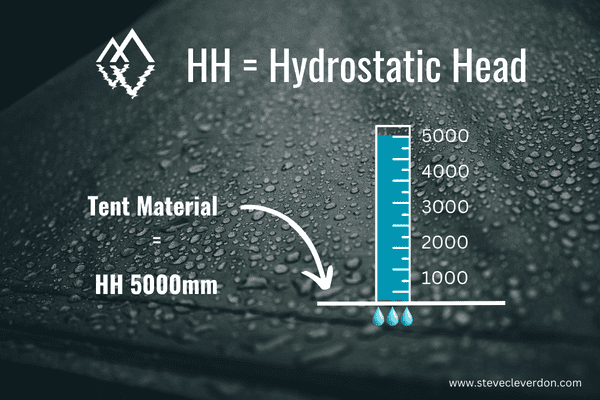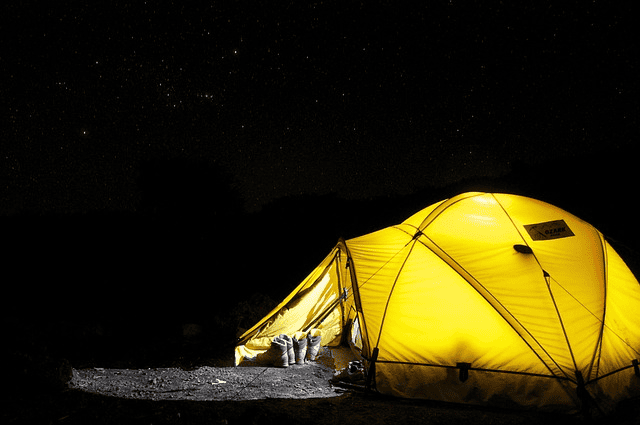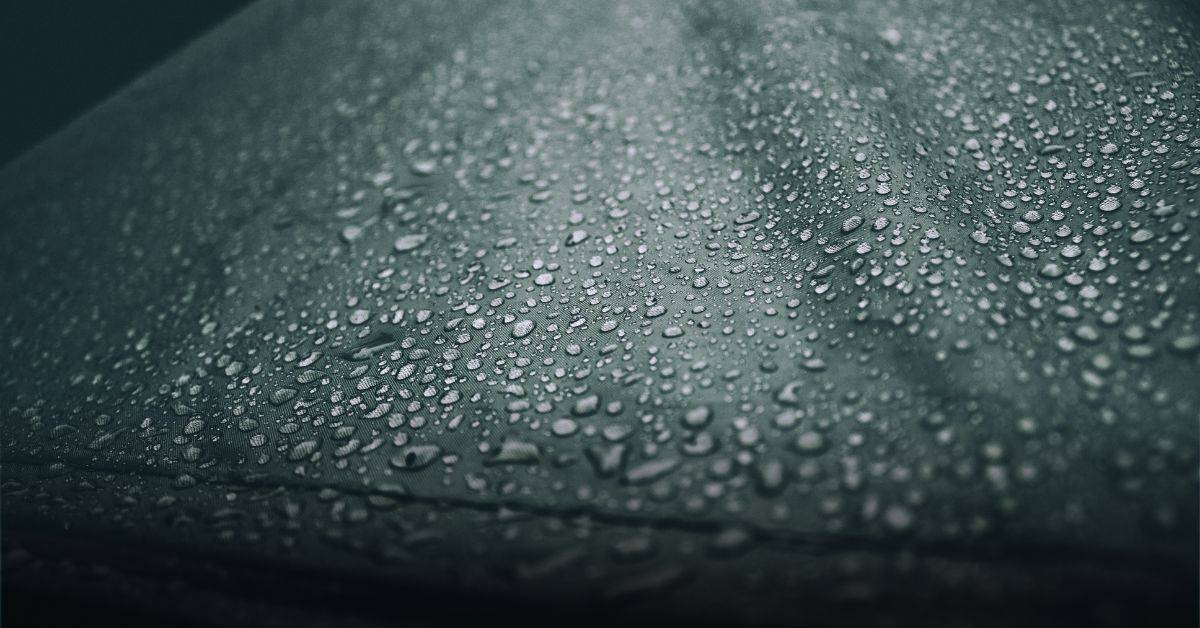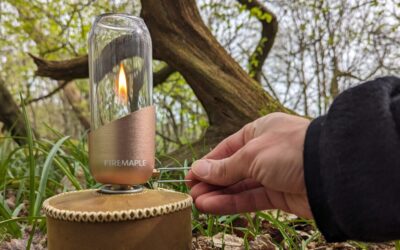When it comes to camping, having a reliable and durable tent is crucial to ensure that you have a comfortable and safe experience. One of the most important factors to consider when choosing a tent is its waterproof rating.
In this article, I will explain how waterproof rating for tents is measured, why it’s important, and how to choose a tent with the right rating.
How is the Waterproof Rating for Tents Measured?
The waterproof rating measures the amount of water pressure a fabric can withstand before it starts to leak.
A higher hydrostatic head or HH rating indicates a more waterproof tent fabric.
The test involves placing a fabric swatch under a 1-inch-diameter cylinder of water. The water is gradually added to the column of water until the fabric begins to leak. The amount of water added at that point is the tent’s waterproof rating.

Most tents have a HH rating, ranging from 1000mm to 10,000mm and beyond.
Here is a breakdown of what the different ratings mean:
1000mm to 3000mm: These tents are suitable for light rain and showers. They offer basic protection against moisture, but heavy rain could penetrate the outer fabric.
3000mm to 5000mm: Tents with this rating offer good protection against moderate rain and wind. They are suitable for most camping trips and many tents can withstand a few days of rain.
5000mm to 10,000mm: These tents are ideal for heavy rain and harsh weather conditions. They offer excellent protection against water and wind and are suitable for camping in extreme conditions.
It’s worth noting that some tents may have different HH ratings for different parts of the tent, such as the groundsheet, rainfly, or main body.
Disclaimer: If you make a purchase via the links on our site, I may earn an affiliate commission at no additional cost to you. You can read my affiliate disclosure in the privacy policy. Thanks for your support!
Factors that Affect Waterproof Rating
The waterproof rating is affected by several factors, including the material, design, construction, and coatings used.
Material
The type of material used in a tent can greatly affect its waterproof rating. Lightweight polyester fabrics are commonly used in backpacking tents but may have lower waterproof ratings compared to heavier canvas tents. Some tent fabrics also feature coatings such as polyurethane or silicone, which can increase their waterproof rating.
Design
The design of a tent can also affect its waterproof rating. Dome tents, tunnel tents, and inflatable air tents all have unique structures that require different waterproof rating requirements. Family tents, which typically have larger sleeping areas, require higher waterproof ratings to accommodate more people and gear.
Construction
The way a tent is constructed can also impact its waterproof rating. For example, tents with taped seams or welded floors may have higher waterproof ratings than those without. Additionally, how the tent is pitched and anchored can also affect its ability to withstand water penetration.
Coatings
Waterproof coatings applied to tent fabrics can increase their waterproof rating. Polyurethane coatings are commonly used and provide tent material with a durable and long-lasting waterproof layer. Silicone coatings are also effective, although they may require more maintenance over time to maintain their waterproof properties.
Understanding how these factors affect a tent’s waterproof rating can help you choose a tent that is best suited for your needs and camping environment. By considering the material, design, construction, and coatings of a tent, you can ensure that you stay dry and comfortable during your camping experience.
Factors to Consider When Choosing a Waterproof Tent
When choosing a tent with a waterproof rating, several factors should be taken into account.
Climate
The climate of the area where you will be camping is an important factor to consider when choosing a tent with a waterproof rating. If you will be camping in an area with heavy rainfall, you will need a tent with a higher hydrostatic head or water column rating to ensure that you stay dry. However, if you will be in a camping area in a dry climate, a lower waterproof rating may be sufficient.
Intended Use
The intended use of the tent is also an important factor to consider. If you will be using the tent for backpacking trips, you may want to choose a tent with a lower waterproof rating to keep the weight down.
However, if you will be using the tent for family camping trips, a higher waterproof rating may be necessary to keep your family dry and comfortable.
Budget
Your budget is another important factor to consider when choosing a tent with a waterproof rating. Tents with higher waterproof ratings are generally more expensive than those with lower ratings.
However, it is important to remember that investing in a higher quality tent with a higher waterproof rating can save you money in the long run by preventing the need for costly replacements or repairs.
Brand
The brand of the tent is also a factor to consider when choosing a tent with a waterproof rating. Established brands such as Terra Nova with a reputation for producing high-quality tents are more likely to provide accurate waterproof ratings and stand behind their products with warranties and customer support.
Other
It is also important to consider the quality and type of tent poles used, as well as their ability to withstand various conditions.
Standard steel poles or aluminum tent poles are more durable than fiberglass poles or carbon fiber tent poles, which may break under harsh weather conditions. Make sure to choose a tent with standard tent poles or replacement poles that are strong and reliable, and can withstand the intended use of the tent.
Considering these factors when choosing a tent with a waterproof rating can help you make an informed decision and select a tent that meets your needs and budget. By choosing a tent with an appropriate waterproof rating, you can ensure that you stay dry and comfortable during your camping experience.

How to Choose the Right Waterproof Rating for Your Needs
When choosing a tent, it’s important to consider the type of camping you’ll be doing and the conditions you’re likely to encounter.
If you’re planning on camping in dry conditions or only occasionally in wet conditions, a lower hydrostatic head rating may be sufficient.
However, if you’re planning on extended trips in wet or windy conditions, you’ll want to look for a tent with a higher hydrostatic head rating to ensure you stay dry.
It’s also worth considering the tent’s overall design and construction. A well-designed tent with good ventilation can help prevent condensation buildup, which can make the interior of the tent feel damp and reduce its overall effectiveness in wet conditions.
Other factors to consider when choosing a tent include its size, weight, and ease of setup. While a tent with a high hydrostatic head rating may be more effective in wet conditions, it may also be heavier and more difficult to set up than a tent with a lower rating. It’s important to find a balance between waterproofing and practicality that works for your specific needs.
Maintenance of a Waterproof Tent
After purchasing a tent with a waterproof rating, it’s essential to maintain it properly. Cleaning and drying the tent after use, storing it correctly, and repairing any tears or holes immediately are all crucial steps to ensure the tent’s longevity.
Cleaning and Drying
Proper cleaning and drying are essential to maintaining the waterproof rating of your tent. It is important to remove any dirt or debris from the tent before packing it up to prevent the accumulation of moisture, which can lead to mould and mildew growth. Use a mild soap and a soft brush to clean the tent, avoiding harsh chemicals or abrasive scrubbing that can damage the waterproof coating.
After cleaning, allow the tent to dry completely before packing it up. Damp or wet tents can lead to the breakdown of the waterproof coating over time, reducing the effectiveness of the waterproof rating.
Storage
Proper storage of your tent can also help to maintain its waterproof rating. Store your tent in a cool, dry place with good ventilation, away from direct sunlight and moisture. Avoid storing the tent in a compressed state for long periods of time, as this can damage the waterproof coating and affect the tent’s ability to repel water.
Repairing Tears and Holes
Even with proper maintenance, tears and holes can occur in your tent over time. It is important to repair any damage to the tent as soon as possible to prevent further deterioration and maintain the waterproof rating. Most tents come with repair kits that include patches and adhesives to fix small tears and holes. For larger tears or damage to the seams, it may be necessary to take the tent to a professional for repair.
Regular maintenance and repairs can help to extend the life of your tent and maintain its water resistance, ensuring that you stay dry and comfortable during your camping experience.
Reviving Your Tent’s Waterproofing
Even with the best care and maintenance, the waterproofing on your tent can diminish over time. When you start to notice that water isn’t beading up on the fabric like it used to, it’s time to give your tent some TLC in the waterproofing department
You can start by spot-checking the tent for areas where the waterproof coating has worn off. These are the spots you’ll want to focus on, though a full tent treatment isn’t a bad idea either. Depending on the condition, you might choose to use a wash-in product or a spray-on waterproofing solution. Make sure to also double-check and possibly re-seal the seams, as they are common areas where leaks begin.
For an in-depth guide on re-waterproofing your tent, check out my detailed article here.
By taking these steps to revive your tent’s waterproofing, you’re not just extending its lifespan; you’re also enhancing your own comfort and safety during your wild camping adventures.
3-Season Vs. 4-Season Tents
Season ratings are also an important consideration when it comes to choosing a waterproof tent. A season rating refers to the type of weather conditions a tent is designed to handle. The most common season ratings are 3-season and 4-season.
3-season tents are designed for use in the spring, summer, and fall. They are typically lightweight and have more ventilation to help keep occupants cool during warmer months. These tents are not designed for use in harsh winter conditions, as they do not provide the necessary protection against heavy snow and high winds.
4-season tents, also known as mountaineering tents, are designed for use in extreme winter conditions, including heavy snow and strong winds. They are typically heavier, have better wind resistance and more durable than 3-season tents and feature sturdier poles and stronger fabric to withstand harsh conditions.
When it comes to waterproofing, 4-season tents are generally more waterproof than 3-season tents. This is because they are designed to withstand heavy snow and rain without leaking. However, it’s important to note that not all 4-season tents are completely or fully waterproof, and some may require additional waterproofing treatments to ensure complete protection against the elements.
When choosing a waterproof tent, it’s important to consider your intended use and the season in which you will be camping. If you plan on camping in harsh winter conditions, a 4-season tent is likely the best option. However, if you plan on camping primarily in the spring, summer, and fall, a 3-season tent may provide adequate protection against the elements while also being more lightweight and easier to carry.
Final Thoughts
Understanding waterproof ratings for tents is an important part of choosing the right tent for your needs.
By considering the type of camping you’ll be doing, the conditions you’re likely to encounter, and the overall design and construction of the tent, you can find a tent that will keep you dry and comfortable no matter what the weather brings.
Whether you’re a weekend camper or a seasoned backpacker, a good tent with a high enough waterproof rating can make all the difference in your camping experience. So, be sure to do your research, and choose a tent that will provide the right level of waterproofing for your needs.
Before you go… don’t forget to grab my free camping checklist for your next trip into the wild.
Waterproof Rating FAQ
What waterproofing rating is recommended for a tent?
It depends on the intended use and conditions you anticipate encountering. A rating of at least 2000mm is recommended for general camping, while a rating of 5000mm or more may be necessary for bad weather conditions.
Is 3000 hydrostatic head good for a tent?
A HH rating of 3000 can provide adequate protection for most camping situations, but it may not be sufficient for heavy rain or prolonged exposure to moisture.
What is the highest waterproof rating for a tent?
The highest waterproof rating for a tent is typically around 10,000mm or more.
Is there a truly waterproof tent?
While there are tents with extremely high ratings against the elements, no tent can guarantee complete protection from water in all situations.
How do I know what tent to buy?
Consider the intended use, if there is enough space for the number of occupants, the weather conditions you anticipate encountering, and other factors such as weight and portability when choosing a tent.
How can you tell if a tent is good quality?
Look for features such as high-quality fabric, sturdy construction, waterproofing, and adequate ventilation to determine if a tent is of good

About the Author
Steve Cleverdon is an adventure blogger dedicated to helping outdoor enthusiasts make the most of their outdoor experiences. With years of travel and many epic adventures including a 3000-kilometre solo hike across New Zealand, Steve has amassed practical knowledge on outdoor gear. You can learn more about his adventures here. Through expert reviews, recommendations, and guides, he equips his readers with the best gear for their next adventure. If you want to send Steve a quick message, visit his contact page here.




